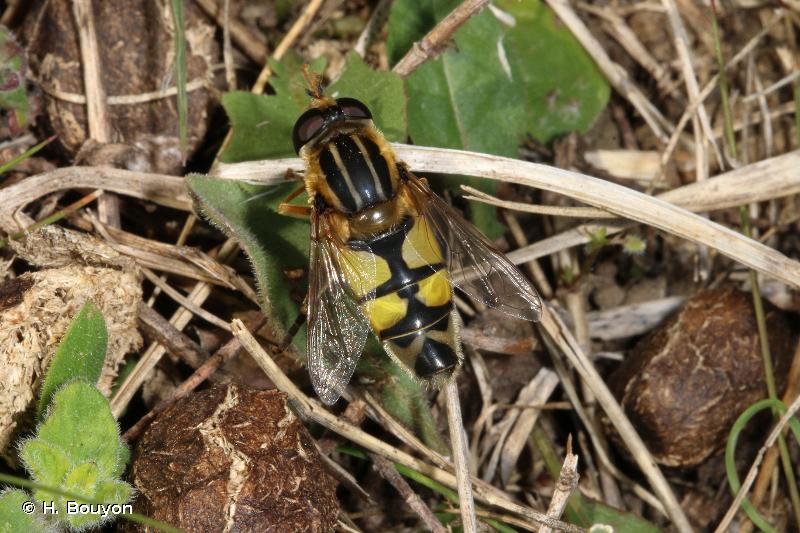
cd_nom

| Author : C. Quintin |
 |
To get the picture, please visit:
Christophe Quintin
email : inpn@mnhn.fr
Despite the Creative Commons license, please inform the author of the use which will be made of his photo

| Author : H. Bouyon |
 |
To get the picture, please visit:
Hervé BOUYON
email : herve.bouyon@wanadoo.fr
Any reuse of one or more photographs on this site is subject to an authorization request from the author.
Link to the Code of Intellectual Property (Legifrance)
Taille :
Grande, 14 à 17mm.
Diagnose :
Le genre Helophilus comprend 3 espèces différentes en France et se reconnaît grâce à ses callus huméraux poilus, son thorax fortement rayé de jaune, ses antennes courtes toujours noires, ses yeux nus et sur l'aile, la première cellule radiale est ouverte et la nervure radiale 4+5 est fortement sinueuse. Helophilus pendulus se distingue par sa face entièrement jaune avec une bande plus sombre au milieu mais jamais noire.
Facilité d'identification :
Relativement facile, peut se faire sur photo.
Confusions possibles :
Confusion possible avec les autres espèces d'Helophilus.
Période de vol:
Les adultes sont visibles de mai à octobre avec un pic au mois d'août en deux générations annuelles.
Répartition générale:
Cette espèce est présente de la Scandinavie jusqu'au bassin méditerranéen et les îles britanniques. Vers l'est elle traverse l'Europe centrale et méridionale, puis la Russie pour atteindre la côte pacifique. Elle est fortement migratrice et peut donc être rencontrée dans des habitats qui ne sont pas favorables à son développement larvaire.
Habitat et biologie:
C'est une espèce des milieux humides. On la retrouve sur le bord des rivières, les prairies humides temporairement inondées et les marais salants. Dans le sud de son aire de répartition elle devient plus anthropophile en utilisant notamment les canaux d'irrigation. Les adultes ont un vol rapide à travers la végétation aquatique, à proximité des zones humides. Les larves sont aquatiques et liées à une eau riche en matière organique qu'elles filtrent pour se nourrir. On peut les retrouver dans la boue souillée par des déjections animales ou dans la végétation pourrissante des plans d'eau.
Speight, M.C.D. (2020) Species accounts of European Syrphidae, 2020. Syrph the Net, the database of European Syrphidae (Diptera), vol. 104, 314 pp., Syrph the Net publications, Dublin.
Thomas Lebard(),2021
Continental
Metropolitan France
Overseas
Marine
Metropolitan France
Overseas
The map presents a summary at the 10 x 10 km grid of the observation data for the species transmitted to the SINP. These data have been subjected to validation filters.
The map presents a reference distribution layer of the species at the scale of departments and marine sectors. The presence and absence data were established by expertise within a network of partners. This reference distribution is used in the validation process of the SINP data at the INPN level.
Corresponds to a report on the basis of at least one observation proved within a period of 10 years (20 years for little-known invertebrates) preceding the year and no presumption of extinction since obtaining the last data nor doubt on reproductive and implemented nature of this population. For migratory species, the presence indicated concerns areas of reproduction.
This status is based on one or more of the following criteria:
This point covers the absence, more difficult by nature to demonstrate than presence. This status is based on one or more of the following criteria:
This status must be assigned to a department in which the presence of the species is casual.
Particular case of absence due to a proven extinction less than a half century ago (older disappearances are treated as "no probable or definite").
In the state of knowledge, we can not comment on the presence or absence in the current department. This is the default status when not comprised in one of the previous categories or whenever there is doubt.
The map shows the global distribution of the species based on GBIF data (Global Biodiversity Information Facility).
